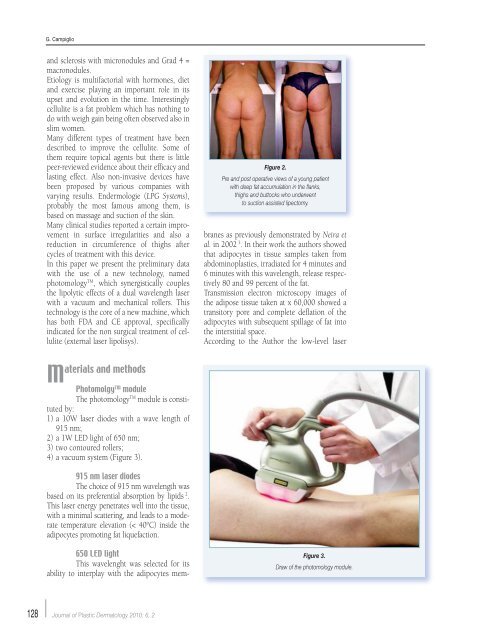Cop ISPLAD - Salute per tutti
Cop ISPLAD - Salute per tutti
Cop ISPLAD - Salute per tutti
Create successful ePaper yourself
Turn your PDF publications into a flip-book with our unique Google optimized e-Paper software.
128<br />
G. Campiglio<br />
and sclerosis with micronodules and Grad 4 =<br />
macronodules.<br />
Etiology is multifactorial with hormones, diet<br />
and exercise playing an important role in its<br />
upset and evolution in the time. Interestingly<br />
cellulite is a fat problem which has nothing to<br />
do with weigh gain being often observed also in<br />
slim women.<br />
Many different types of treatment have been<br />
described to improve the cellulite. Some of<br />
them require topical agents but there is little<br />
peer-reviewed evidence about their efficacy and<br />
lasting effect. Also non-invasive devices have<br />
been proposed by various companies with<br />
varying results. Endermologie (LPG Systems),<br />
probably the most famous among them, is<br />
based on massage and suction of the skin.<br />
Many clinical studies reported a certain improvement<br />
in surface irregularities and also a<br />
reduction in circumference of thighs after<br />
cycles of treatment with this device.<br />
In this pa<strong>per</strong> we present the preliminary data<br />
with the use of a new technology, named<br />
photomology TM , which synergistically couples<br />
the lipolytic effects of a dual wavelength laser<br />
with a vacuum and mechanical rollers. This<br />
technology is the core of a new machine, which<br />
has both FDA and CE approval, specifically<br />
indicated for the non surgical treatment of cellulite<br />
(external laser lipolisys).<br />
aterials and methods<br />
m<br />
PhotomolgyTm module<br />
The photomologyTM module is constituted<br />
by:<br />
1) a 10W laser diodes with a wave length of<br />
915 nm;<br />
2) a 1W LED light of 650 nm;<br />
3) two contoured rollers;<br />
4) a vacuum system (Figure 3).<br />
915 nm laser diodes<br />
The choice of 915 nm wavelength was<br />
based on its preferential absorption by lipids 2 .<br />
This laser energy penetrates well into the tissue,<br />
with a minimal scattering, and leads to a moderate<br />
tem<strong>per</strong>ature elevation (< 40°C) inside the<br />
adipocytes promoting fat liquefaction.<br />
650 LED light<br />
This wavelenght was selected for its<br />
ability to interplay with the adipocytes mem-<br />
Journal of Plastic Dermatology 2010; 6, 2<br />
Figure 2.<br />
Pre and post o<strong>per</strong>ative views of a young patient<br />
with deep fat accumulation in the flanks,<br />
thighs and buttocks who underwent<br />
to suction assisted lipectomy.<br />
branes as previously demonstrated by Neira et<br />
al. in 2002 3 . In their work the authors showed<br />
that adipocytes in tissue samples taken from<br />
abdominoplasties, irradiated for 4 minutes and<br />
6 minutes with this wavelength, release respectively<br />
80 and 99 <strong>per</strong>cent of the fat.<br />
Transmission electron microscopy images of<br />
the adipose tissue taken at x 60,000 showed a<br />
transitory pore and complete deflation of the<br />
adipocytes with subsequent spillage of fat into<br />
the interstitial space.<br />
According to the Author the low-level laser<br />
Figure 3.<br />
Draw of the photomology module.

















